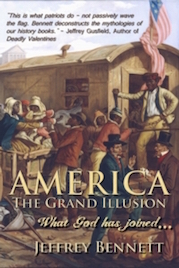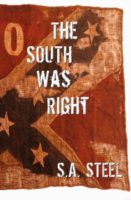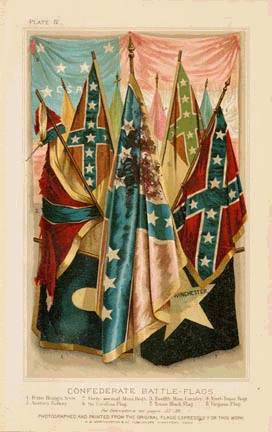 At the very deepest level there is a central truth about the War Between the States which is now, even by the best of Southerners, almost never mentioned, although their forefathers had once spoken of its importance continuously. Indeed, they put emphasis upon it long after the War was over. From 1850 until 1912, this explanatory assumption was a commonplace component of one understanding of the meaning of that great conflict. And to most Southerners, it seemed almost as self-evident as did the equivalent formulations to their Northern counterparts—especially in the years of Antebellum dispute over the morality of slaveholding and other distinctions of “character” separating the two original versions of American civilization. When Confederate Southerners stood ready to face death in the place where the battle was joined or when they came to write apologia for their conduct, they saw themselves as part of a struggle between “powers and principalities,” alternative conceptions of the human enterprise—not merely as adjuncts to competing schemes for gathering political power. Southerners, of course, fought to defend themselves and their view of the Constitution. They fought out of a loyalty to “hearth and rooftree,” and to what had been achieved by Americans in general between 1774 and 1791. Further, they were animated by a sense of personal honor and were therefore unwilling to continue association with their detractors within the federal bond once condemned by their erstwhile countrymen to live under the insufferable burden of high-handedness and effrontery. But that is not all of the story concerning their reasons for secession—not even the most interesting part.
At the very deepest level there is a central truth about the War Between the States which is now, even by the best of Southerners, almost never mentioned, although their forefathers had once spoken of its importance continuously. Indeed, they put emphasis upon it long after the War was over. From 1850 until 1912, this explanatory assumption was a commonplace component of one understanding of the meaning of that great conflict. And to most Southerners, it seemed almost as self-evident as did the equivalent formulations to their Northern counterparts—especially in the years of Antebellum dispute over the morality of slaveholding and other distinctions of “character” separating the two original versions of American civilization. When Confederate Southerners stood ready to face death in the place where the battle was joined or when they came to write apologia for their conduct, they saw themselves as part of a struggle between “powers and principalities,” alternative conceptions of the human enterprise—not merely as adjuncts to competing schemes for gathering political power. Southerners, of course, fought to defend themselves and their view of the Constitution. They fought out of a loyalty to “hearth and rooftree,” and to what had been achieved by Americans in general between 1774 and 1791. Further, they were animated by a sense of personal honor and were therefore unwilling to continue association with their detractors within the federal bond once condemned by their erstwhile countrymen to live under the insufferable burden of high-handedness and effrontery. But that is not all of the story concerning their reasons for secession—not even the most interesting part.
Southerners had, by the time they left the Union, serious doubts about what kind of country the United States was about to become. It was not only what the Yankees were attempting to do to the South but, even more important, what they were doing to themselves which made the moral and intellectual leaders of our region doubt whether they wished to leave their children in any political or moral connection with the modern power state emerging above the Old Surveyors’ Line.
In the North was a regime whose primary faith was in the human will and intellect, in the ability of man through science and politics to subdue the entire Creation and reshape it according to his fondest dreams. The political form of this culture was that of a juggernaut, embodying a radical spirit, which, according to Admiral Raphael Semmes, “seemed to be now what it had been in the Great French Revolution, a sort of mad-dog virus,” making “rabid” all who wore touched by it. Writing in the same vein, the Virginia theologian William H. Hall, in his The Historic Significance of the Southern Revolution (1864), writes of his comrades in the Confederate army, “We are permitted to vindicate the supremacy of Jehovah’s word and the purity of His government.” The disposition of Northern clergy to divinize human nature and to glorify human reason Hall deplored. At some length he explained how they came to embrace such heresy. Then he used the same historical evidence to draw another line from enemies of the French Revolution to the Southern counterrevolution, coming thus to conclude that “this explains why the Southern Clergy, standing aside for the time from all their previous practice, have shown such an active sympathy with this political revolution.” At Which point he quotes with approval the Rev. B. M. Palmer: “It is not only from the impulse of a lofty patriotism, grand as that sentiment may be, but out of loyalty to God against whose rightful supremacy a wicked infidelity has lifted its rebellious arms.” This explanation of secession as holy war against the presumptions of modern thought recalls to our attention that the Confederate Constitution acknowledged the sovereignty of God over the political order. The Southern social and political philosopher Richard Weaver has described the Old South as “the last non-materialist civilization in the Western world”—a culture still immune to the ontologically aggressive spirit against which Semmes, Hall, and Palmer wrote. But the Antebellum North was a very different case.
In his Second Inaugural Address, President Abraham Lincoln raised the question of why war had occurred when Southerners “read the same Bible and pray to the same God.” Since both parties “deprecated war” and were otherwise so well agreed, how was it that “the war came”? However, if we inquire closely into the regnant Northern myths of Speed and Mass, of Union and Progress, as these functioned in the cultural rhetoric of contemporary Northern commentary on what they called “The Rebellion,” then we must ask whether the Great Emancipator was not in this instance (as in so much else) very much mistaken in his assumptions. For the generic Southerner, to quote once again from Professor Weaver, had a “deep, even frightening intuition of man’s radical dependence.” As Professor Bell Wiley observes, the Southern churches had always warned their communicants against “extreme confidence in human endeavor.” The ordinary Southerner of 1860 did not approach the world as did those who had voted for Mr. Lincoln. They were, as Anne C. Loveland observes in her Southern Evangelicals and the Social Order, 1800-1860, “as dubious of human ability in social and political matters as in the matter of salvation. The belief in the sovereignty of God and dependence of man was the whole of their thinking.” Nor did they change their minds about these things after Appomattox. According to the classic formulation of Oswald Spengler, modern man has his prototype in the figure of Dr. Faustus, the omnicompetent master of all the sciences, the alchemist who somehow summarizes the restless spirit of Western civilization since the beginning of the Renaissance. If Spengler’s explanation is correct, the Antebellum Southerner was not modern, even though his adversary was. For that Southerner could not believe that engineering, medicine, and the popular ballot could cure all the ills the flesh is heir to. And therefore he was in the way.
The epitome of the religious spirit of the Old South was in the life of the Confederate Army, in the field or in encampment. E. Merton Coulter tells us that in the winter of 1863-1864 there were religious services almost every night when one of the major Confederate forces was not directly engaged in battle. Authorities on these events are William W. Bennett’s A Narrative of the Great Revival Which Prevailed In the Southern Armies During the Late Civil War Between the States of the Federal Union (1876), and J. William Jones’ Christ in the Camp or Religion in Lee’s Army (1887). Most of these meetings, as Henry Lee Curry III tells us in his God’s Rebels: Confederate Clergy in the Civil War (1990), were revival services assembled by the soldiers themselves and conducted either by clergymen in the army or ministers who journeyed to the front lines in order to reinforce the resurgent belief in the Christian promises there in evidence. The immediate motive of these shepherds was their hope (and determination) that the young men under their influence would not die outside the faith. But it was not only the young who were converted while under arms. Generals Braxton Bragg, Joseph E. Johnston, William J. Hardee, Dick Ewell, and John B. Hood (to mention only a few) were converted and/or baptized while in Confederate service, along with perhaps 150,000 men in gray. Soldiers in the Army of Northern Virginia formed the Army Christian Association which held prayer meetings three times a week. And a young officer in Bragg’s headquarters in North Georgia wrote to his family that “thousands have professed religion and the work is still going on.”
One wag observed of Stonewall Jackson’s command in the Valley of Virginia that it was more like a “protracted meeting” than an army on the march. And everyone knows that there was enough theological expertise on General Jackson’s staff to form the faculty of a Presbyterian seminary, that the discussion of abstruse theological questions was the General’s favorite occupation—that is, next to driving the Yankees before him, “the blue-coated hosts of Beelzebub.” No equivalent religious activity went on in the Union Army. For many enlisted there, the nation itself was a gathered church, and its cause a sacred creed—one of the many varieties of evidence supporting the opinion of Admiral Semmes that “no two peoples, speaking the same language and coming from the same country, could have been more dissimilar.”
To quote Coulter once more, the Confederate army was extraordinary among modern forces of its size—in this with no rival but Cromwell’s host—in being “free of vice.” Modern armies in Europe, in Mexico, or (during the American Revolution) in the Northeast were gathering places for speculators, sutlers, harlots, gamblers, and whiskey merchants. Americans had seen all of this in their earlier wars, the ancient definition of an army as including everything and everyone moving with its train. Such conglomeration was common with Northern armies. The Confederate soldier was, of course, no angel. All of the aforementioned preaching aimed at his immortal soul presupposes that, in matters covered by those exhortations, certain improvements were in order. But Johnny Reb, if he wanted to get into any serious mischief, had to go to town.
The armies of the Confederacy were not like a modern professional force but instead resembled a patriarchal Scots clan, an extended family made up of men connected by blood and marriage, common enterprises, and a common foe. How and why they fought consorted well together. And the importance of religion among them should be seen in the context of this larger characterization of the society they represented. According to the late Clement Eaton, “In 1860 there was little disagreement between the fundamental beliefs of the lower and upper classes of the South.” By this he meant that Episcopalians and “hardshell” Baptists were, in basic theology, similar. Moreover, their sense of the mortal danger threatening the very existence of their people, of the “mad fanaticism of the North,” made them astonishingly sober about the business of war. But to this theory we must add another ingredient to complete our analysis of their martial piety.
A great part of the explanation for this special and collective grace comes not from Northern malice or desperate military circumstances but from the unusual relationship of the Southern clergy to the effort made by their region to achieve its independence. As I noted earlier, almost to a man, the religious leaders of Antebellum Southern society called for secession and led the way in reconciling the people of the South to all the hardships secession would cost them: taught them that separation from the North was a “holy enterprise.” And in numberless sermons and religious publications, they explained their attitudes with commentary on what was wrong with Northern religion. The Reverend James A. Duncan, Methodist clergyman and editor of the Richmond Christian Advocate, declared that his Northern counterparts were “advocates of every semi-infidel notion which could be stated.” Northern reformers “confused politics with the Gospel of Christ.” Such argument was the common fare of Southern religious journalism. The number of Southern ministers who went forth to battle with the men of their congregations, either as chaplains or as men-at-arms, was astonishingly high; and, as we learn from the slightly modified story of the Reverend John Stevens, as reported by John W. Thomason in his Lone Star Preacher (1941), what began for many of them as an effort to give comfort and encouragement turned, once at the front, into a more inclusive kind of leadership—most often as junior officers, as the commanders of companies and regiments. And they did not change their minds about what they had done for Southern independence, not even after military defeat. Indeed, those who had served in gray, though gentle and modest Christians, were proud of that service for the remainder of their days.
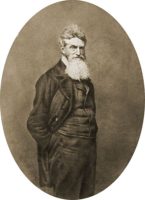
John Brown, 1859
To account for the secessionist unanimity of these men, from the humblest circuit rider to Bishop Leonidas Polk and such well-known ministers as M. P. Lowrey and William Pendleton (all general officers), we must look to the special features of their vocational experience in the years before the War. Charles Roland, one of our best Southern historians, has written that “the major buttress of the Confederacy was religion.” He is correct in this generalization because most Southern clergymen were, during the years of sectional conflict within their denominations, convinced that “apostasy” and “Infidelity” had become the dominant religions of the North. In national meetings and in religious publications, they had confronted the various “isms” infecting the New England mind—what Cushing Strout calls “the political religion of America.” They had come to understand that Progress was a substitute religion, in lieu of religion as divine revelation and the cure of souls: a substitute which commits its victims to an endless sequence of changes for the sake of worldly change; another version of that old standby, the golden calf, in recent years usually seen in disguise
as the Goddess of Reason. Finally, they had listened when Theodore Parker, speaking for thousands of his kind, insisted on treating “each man as his own Christ,” declaring that “true religion was independent of the Revelation of the Bible.” And listened also when Ralph Waldo Emerson predicted that John Brown (above), once hanged, would “make the gallows as glorious as the Cross.” As the War approached, these clergymen more and more tended to view the sectional controversy as a dispute between those who acknowledged the authority of the Scripture and those who set their own moral sense above it—in other words, between Christians and infidels.
What signified in Northern attacks on slavery was Yankee unwillingness to be satisfied with a Biblical case, not their personal preference for a free society. Southern criticism of Northern theologians, as Eugene Genovese demonstrates in his “Slavery Ordained of God”: The Southern Slaveholders’ View of Biblical History and Modern Politics (1985), made much of this distinction as to method or approach. In exalting their own religious sense above the historic witness of the Church the abolitionists blasphemed. And if they behaved that way on one issue, using hieratic language to explore their own endlessly fresh revelation, they might well be expected to do the same in another context. This could not be suffered—or corrected by a continuous and corrosive appeal to reason. For as De Bow’s Review observed a few months after Appomattox, “Every bloody revolution in Christendom, as well in Church as in State, for the last three hundred years, has been brought about by following the too often deceptive guide of reason.”
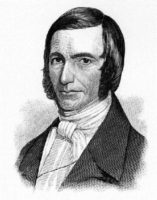
James Henley Thornwell
The great Southern theologians, Robert L. Dabney, James Henley Thornwell, and B. M. Palmer, as much as the ordinary Southern soldiers, saw it as an error to put final confidence in the capacity of human agency to accomplish a moral revolution. To think that way was to put one’s trust in “works”—an error about which they had been warned since childhood and against which, as good Christians, they were thoroughly persuaded. As mythopoeic men, they saw both nature and history as providential: saw them in operation, as an action, not a set of propositions. In other words, underneath their politics was a firm theological foundation, one recognized by Richard Weaver but ill understood in conventional works such as James W. Silver’s influential Confederate Morale and Church Propaganda. This is the truth about this history that, under pressure from the resurgent theory of the War as the North’s moral crusade, we have so often forgotten: misplaced to our own confusion and the comfort of those who are still our enemies, even as we argue about the past. For all of the great issues fought out in the 1860s are with us still, sometimes disguised, but in their fundamental character never changing.
We all know of the famous Confederate war cry, the ubiquitous “rebel yell” raised in battle from Wilson’s Creek and Shiloh to Valverde and Brice’s Crossroads. But the sound our forefathers made while rushing upon the enemy in hot blood was not always the old Celtic war whoop of men ready to kill or be killed. Sometimes the anthem, when Federal legions stood ready to receive their assault, when death was the probable (not the possible) consequence of what they were doing, was a more solemn music. Writes the Reverend S. M. Cherry from Georgia in May of 1864:
About the fifth instant, the soldiers were called from their camps to meet the enemy in the vicinity of Oakton—they literally went from the altar to their entrenchments—from their knees to the battle with their foes—still singing the songs of Zion and supplicating the throne of grace as they surrounded the fires of the bivouac, or waited to receive the fire of the foe.
Instead of a battle cry, they raised a hymn, probably in a minor key, one of the white spirituals preserved by the shape note singers, or music close akin (see Charles F. Pitt’s Chaplains in Gray [1957]). We have many stories of such moments—from the field at Franklin, from Sharpsburg, Bentonville and Cold Harbor; but most memorably from the first day at Shiloh where, in the last of many charges against Prentiss’ brigade, several units under the command of General John Breckinridge, weary and shattered by repeated encounters with the foe, were urged by a few of their officers to break out in the then familiar hymn “We Shall March Away to Battle” and, picking up the tune, rose as a man to follow those officers toward their apotheosis in sheets of flame. In that moment, they personified the Confederate South at a level of its experience and commitment which talk of constitutional punctilio and the rights of secession do not begin to explain—at a level where it could not be defeated unless or until it willingly agreed to its own ruin and distortion. When and whether that happened is a question for our time, not for the men who sang their way to death that spring afternoon in Tennessee in the woods, where the dogwood bloomed.
In such fierce and lovely moments, a “Solid South,” the “buried nation” of our ancestors, was born. For in defeat and in the bondage of enemy occupation, Southerners could think of themselves as a people called out to a special witness, a righteous nation surviving in the midst of modernity, sealed forever in its covenant by defeat and freedom from the besetting ambitions of the victorious, progressive North. Or so the soldier-clergymen, taught by the experience of the War, encouraged them to believe. The consequences of their admonition are among us still, setting most Southerners aside from the primary delusions of our place and time. Historians who wish to understand Southern persistence in character would do well to consider this evidence, and be less concerned with explanations of Southern particularity which derive from slavery alone.
Written by Melvin E. “Mel” Bradford and published by The Abbeville Review ~ June 14, 2016.
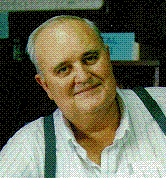
Melvin E. Bradford
~ The Author ~
Melvin E. “Mel” Bradford (1934-1993) was a conservative political commentator and Professor of Literature at the University of Dallas.. He was the author of A Better Guide than Reason: Federalists and Anti-Federalists, Original Intentions: On the Making and Ratification of the Constitution, Founding Fathers: Brief Life of the Framers of the Constitution, and The Reactionary Imperative: Essays Literary & Political.
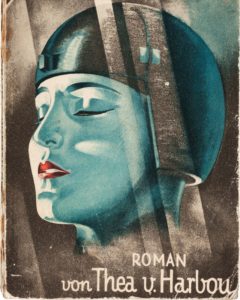 FAIR USE NOTICE: This site contains copyrighted material the use of which has not always been specifically authorized by the copyright owner. We are making such material available in our efforts to advance understanding of environmental, political, human rights, economic, democracy, scientific, and social justice issues, etc. We believe this constitutes a ‘fair use’ of any such copyrighted material as provided for in section 107 of the US Copyright Law. In accordance with Title 17 U. S. C. Section 107, the material on this site is distributed without profit to those who have expressed a prior interest in receiving the included information for research and educational purposes. For more information go to: http://www.law.cornell.edu/uscode/17/107.shtml
FAIR USE NOTICE: This site contains copyrighted material the use of which has not always been specifically authorized by the copyright owner. We are making such material available in our efforts to advance understanding of environmental, political, human rights, economic, democracy, scientific, and social justice issues, etc. We believe this constitutes a ‘fair use’ of any such copyrighted material as provided for in section 107 of the US Copyright Law. In accordance with Title 17 U. S. C. Section 107, the material on this site is distributed without profit to those who have expressed a prior interest in receiving the included information for research and educational purposes. For more information go to: http://www.law.cornell.edu/uscode/17/107.shtml

